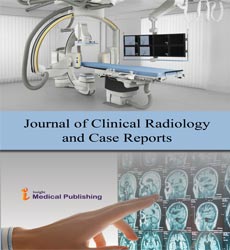Radiology and Nuclear Medicine in the Era of Cutting Edge Medicine
Department of Nuclear Medicine, Soonchunhyang University Hospital, Bucheon, Republic of Korea
- *Corresponding Author:
- Jae Pil Hwang
Department of Nuclear Medicine
Soonchunhyang University Hospital
170 Jomaru-ro, Wonmi-gu, Bucheon, Republic of Korea
Tel: 82-32-621-6832
Fax: 82-32-621-5749
E-mail: zandazanda@nate.com
Received date: August 10, 2017; Accepted date: August 11, 2017; Published date: August 18, 2017
Citation: Hwang JP. Radiology and Nuclear Medicine in the Era of Cutting Edge Medicine. J Clin Radiol Case Rep 2017, Vol.1 No.1:01.
Copyright: © 2017 Hwang JP. This is an open-access article distributed under the terms of the Creative Commons Attribution License, which permits unrestricted use, distribution, and reproduction in any medium, provided the original author and source are credited.
Editorial
Over the past decade, there have been significant advances in radiologic, nuclear molecular and fusion imaging using various diagnostic materials and electric technology.
Recently, several cutting-edge medicines such as precision medicine, molecular imaging, target or immunotherapy, gene based technology (CRISPR) and artificial intelligence are being magnified as a new clinical field of medicine.
Precision medicine is an emerging approach for disease prevention and treatment that takes into account variations in genes, environment, and lifestyle among individuals. It integrates research disciplines and clinical practice to build a knowledge base that can better guide individualized patient care [1].
The convergence of genetics, informatics, and imaging, along with other technologies such as cell sorting, epigenetics, proteomics, and metabolomics, is rapidly expanding the scope of precision medicine by refining the classification of disease, often with important prognostic and treatment implications. Imaging is not always considered as part of precision medicine, yet it has profoundly changed how we treat patients. High End computed tomography, magnetic resonance imaging, ultrasonography and positron emission tomography with computed tomography (PET/CT) provide greater sensitivity and specificity in the preoperative diagnosis and being used to guide management decisions [2].
Molecular imaging is defined as the visual representation, characterization, and quantification of biological processes at the cellular and subcellular levels within intact living organisms; this can be achieved by various imaging technologies such as nuclear imaging, optical imaging, magnetic resonance imaging (MRI), ultrasound imaging, and computed tomography (CT) [3].
Targeted therapy is gaining importance due to its specificity towards cancer cells while sparing toxicity to off-target cells [4]. Cancer immunotherapy, the treatment that harnesses the patient’s immune system to fight cancer, is now emerging as an important addition to conventional therapies [5].
Artificial intelligence (AI), is defined as a field of science and engineering concerned with the computational understanding of what is commonly called intelligent behavior, and with the creation of artefacts that exhibit such behavior, is being magnified as a new diagnostic or interpretable modality [6].
Genetics and DNA sequencing methods are having the greatest effect among the new recent technologies. Especially, genome editing with the advent of clustered, regularly interspaced, short palindromic repeats (CRISPR) now promise to take drug development and regenerative medicine to new levels and to enable the interrogation of disease mechanisms with a hitherto unimaginable level of model fidelity [7].
At this point in time, radiology and nuclear medicine need to develop that match changes in clinical needs. And diagnostic, therapeutic radiology and nuclear medicine should be harmonized with each other, introduce their recent technique, share data, update knowledge and react quickly to rapidly changing clinical setting.
Recent advances in chemistry and electrical engineering of radiologic imaging instruments have expended the application of radiologic and nuclear molecular imaging as an imaging tool that is now able to show the structural, functional and molecular characteristics of various diseases in the clinical setting. It is obvious that radiologic and nuclear molecular imaging will play an important role in recent medicine and will contribute to various clinical fields.
Finally, I am pleased to serve as the editor of Journal of Clinical Radiology and Case Reports and to have the opportunity to contribute this editorial.
Conflict of Interest
The author Jae Pil Hwang declares that he has no conflict of interest.
References
- Bahcall O (2015) Precision medicine. Nature 526: 335.
- Jameson JL, Longo DL (2015) Precision medicine-personalized, problematic, and promising. Obstetrical and Gynecological Survey 70: 612-614.
- Kelkar MG, Senthilkumar K, Jadhav S, Gupta S, Ahn BC, et al. (2016) Enhancement of human sodium iodide symporter gene therapy for breast cancer by HDAC inhibitor mediated transcriptional modulation. Scientific Reports 6.
- Padma VV (2015) An overview of targeted cancer therapy. Biomedicine 5: 19.
- Farkona S, Diamandis EP, Blasutig IM (2016) Cancer immunotherapy: the beginning of the end of cancer? BMC Medicine 14: 73.
- Ramesh AN, Kambhampati C, Monson JRT, Drew PJ (2004) Artificial intelligence in medicine. Annals of the Royal College of Surgeons of England 86: 334-338.
- Waddington SN, Privolizzi R, Karda R, O’Neill HC (2016) A broad overview and review of CRISPR-cas technology and stem cells. Current Stem Cell Reports 2: 9-20.
Open Access Journals
- Aquaculture & Veterinary Science
- Chemistry & Chemical Sciences
- Clinical Sciences
- Engineering
- General Science
- Genetics & Molecular Biology
- Health Care & Nursing
- Immunology & Microbiology
- Materials Science
- Mathematics & Physics
- Medical Sciences
- Neurology & Psychiatry
- Oncology & Cancer Science
- Pharmaceutical Sciences
